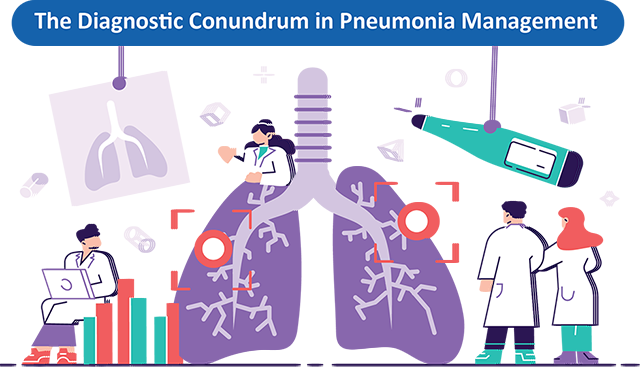Pneumonia is a form of acute lower respiratory infection. It is characterized by the deposition of fluid and/or pus in the alveoli, limiting oxygen exchange and making breathing painful and difficult.
Pneumonia is usually caused by viruses or bacteria and rarely by other microorganisms. It is the leading cause of death, especially in children below the age of 5 and adults over 65.1 There are over 30 different causes of pneumonia and are grouped as bacterial pneumonia, viral pneumonia, fungal pneumonia, and other pneumonia. They can also be categorized as community-acquired, hospital-acquired, or aspiration pneumonia.2
Pneumonia affects approximately 450 million people worldwide and leads to 4 million deaths each year. India accounts for over 23% of the global pneumonia burden. With over 30 million new cases of childhood pneumonia reported each year, India tops the list of countries with a high disease burden.3


Pneumonia
is a difficult disease to diagnose. It could be caused by many pathogens that
could lead to bacterial, viral, or fungal infection in the lungs and can be
contracted anywhere, including the hospitals.
Until recently, chest X-rays were considered the best tool for detecting all
types of pneumonia; however, they may not be perfect. Scans could appear
similar for different conditions, and imaging makes it difficult to identify
the pathogens causing the infections. This makes it challenging to diagnose
pneumonia via X-rays. Also, this is more evident when the patients experience
several health problems simultaneously.
Physicians must gather a clear and complete picture of the patient’s condition
to come up with an accurate diagnosis of their problems. Although a complete
blood work could be arranged for, in addition to an X-ray, the value of such
results may be of limited value. The results could be indicative of
pre-existing conditions and not necessarily pneumonia. In such cases, the use
of Artificial intelligence to support clinical decisions seems to be a rather
promising concept.4

Artificial intelligence appears to be a powerful tool that
can aid in diagnosing and managing pneumonia by mimicking and supplementing the
clinical-decision making of physicians. Computational performance using machine
learning (ML) and neural network (NN) models allow for extensive mathematical
operations and streamlining of high quantity data quickly, which prove to be
extremely useful during clinical practice. The availability of data from
electronic health records (EHR) and advances constantly being made in
computational performance are two major factors that highlight the connection
between AI and regular medical practice.
With the constantly increasing data and variables related to patient care, and
the constant up-gradation of medical literature, these models verify and
confirm all data retrieved from electronic health records and facilitate
optimal improvements in patient care. Treatment strategies could also be
strategized and optimized based on results obtained from clinical situations
like using multi-drug therapies, antibiotic resistance patterns, potential
risks associated with treatment protocols, risks related to readmissions, etc.5
The
information on the use of AI in improving pneumonia management is limited. AI
has greater application potential in medical imaging in cases where the data is
easier to obtain. A handful of studies highlight the detailed data about which
AI method was used to diagnose and manage pneumonia.
Chest radiographs are the most common diagnostic imaging tools at present. They
are still used to screen, diagnose and manage pneumonia and other related
diseases. In the coming years, AI systems could be more than handy and
technologically useful for physicians, nurses, and physician assistants in the
emergency department. The AI tool needs to be fed with several patients'
radiograph files, and the process needs to be fine-tuned. Also, when compared
with manually coming up with a diagnosis, the AI tool is faster compared to
even board-certified radiologists.6

Use of AI in decision making process for empiric antibiotics
Antibiotic resistance is a massive public health burden and is of utmost
priority to hospitals worldwide. Huge amounts of data, prescription patterns,
and how patients respond to the treatment need to be gathered and analyzed at
all times. AI would come in handy and pose as an important tool to automate
this process of auditing the usage of antibiotics to ensure optimal use to
improve patient care and reduce mortality. AI in pneumonia management could
help identify the treatment profiles of patients and narrow it down to the
cases that require immediate attention. It could suggest the appropriate
antibiotics for each case and provide optimum guidance to clinicians at the
point of prescription. Also, speed is of the essence for the success rate.
While manual processes could take several minutes, AI can assess the same data
in seconds, helping healthcare providers provide empiric antibiotic therapy for
effective antibiotic resistance cases.10
Artificial intelligence can certainly be a powerful ally in the
fight against the spread of pneumonia. AI can give doctors and other healthcare
professionals a leg up when tracking and understanding the spread of pneumonia.
AI can also help diagnose pneumonia and assist doctors to develop a better
understanding of how to treat and manage the illness better.
Reference: